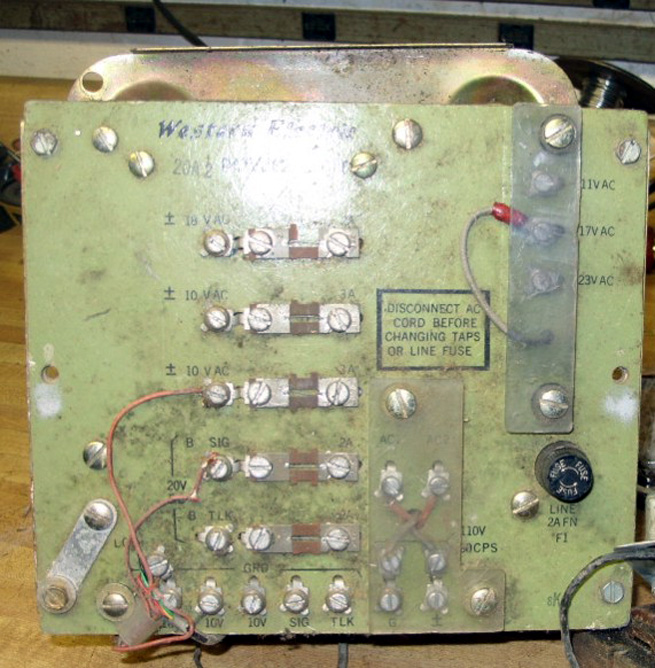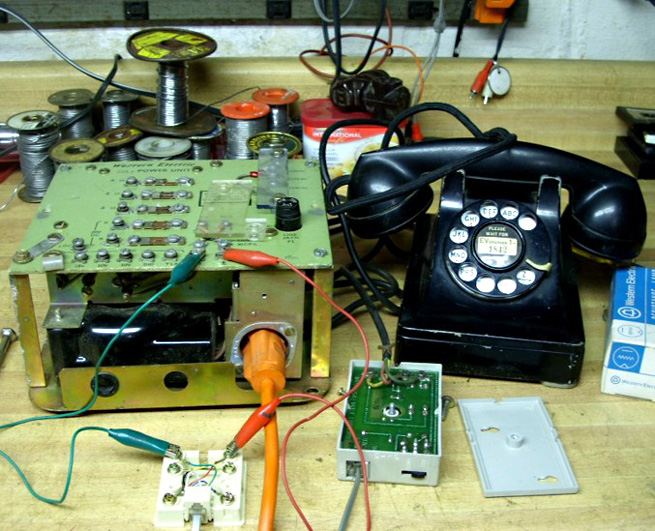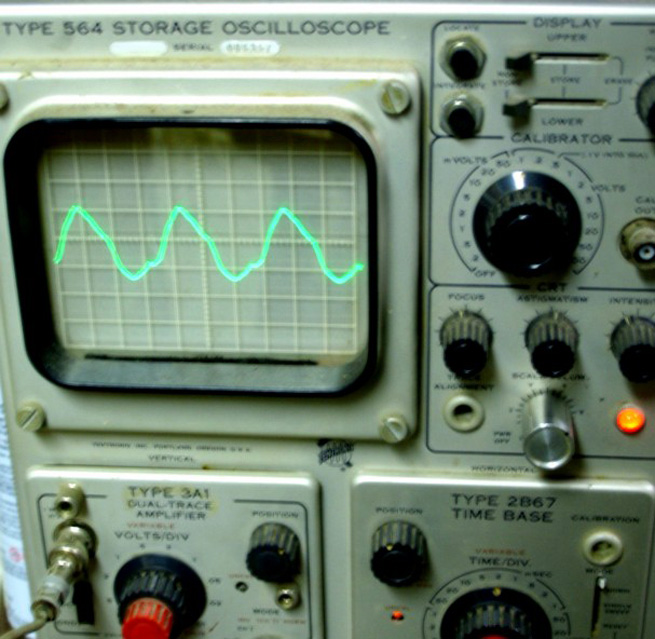Vintage Telephones
Forum home - Go back to Vintage Telephones
|
Compact PBX Ring Generator
|
|
|
Return to top of page · Post #: 1 · Written at 12:49:10 AM on 28 January 2014.
|
|
|
|
Location: Silver City WI, US
Member since 10 May 2013 Member #: 1340 Postcount: 977 |
|
Supplies 110v-30CPS ring power and an array of other voltages (including the ubiquitous 18vAC) in compact wall mount. Uses main transformer, then 'secret' potted module that has shape of a toroidal transformer + Electrolytic caps to cleverly halve mains frequency for ring. AC supplied through standard (for the time) Hubbell 'Twist-Lock' receptacle. Estimated vintage early 60s as CPS is used not Hertz.  |
|
|
Return to top of page · Post #: 2 · Written at 1:38:28 AM on 28 January 2014.
|
|
|
|
Location: Sydney, NSW
Member since 28 January 2011 Member #: 823 Postcount: 6896 |
|
Will come in handy for testing vintage phones. |
|
|
Return to top of page · Post #: 3 · Written at 7:13:43 AM on 28 January 2014.
|
|
|
|
Administrator
Location: Naremburn, NSW
Member since 15 November 2005 Member #: 1 Postcount: 7571 |
|
When photos are intended it is best to say "Photos coming" or similar. ‾‾‾‾‾‾‾‾‾‾‾‾‾‾‾‾‾‾‾‾‾‾‾‾‾‾‾‾‾‾‾‾‾‾‾‾‾‾‾‾‾‾‾‾‾‾‾‾‾‾‾‾‾‾‾‾‾‾‾‾‾‾‾‾‾‾‾‾ A valve a day keeps the transistor away... |
|
|
Return to top of page · Post #: 4 · Written at 10:07:02 AM on 28 January 2014.
|
|
|
|
Location: Sydney, NSW
Member since 28 January 2011 Member #: 823 Postcount: 6896 |
|
Nice find. Where did you find it? |
|
|
Return to top of page · Post #: 5 · Written at 2:03:19 PM on 28 January 2014.
|
|
|
|
Location: Silver City WI, US
Member since 10 May 2013 Member #: 1340 Postcount: 977 |
|
It's a model 20A -2 , Found Tech Bulletin (link) - dated 1978. |
|
|
Return to top of page · Post #: 6 · Written at 11:49:58 PM on 28 January 2014.
|
|
|
|
Location: Sydney, NSW
Member since 28 January 2011 Member #: 823 Postcount: 6896 |
|
Thanks for the technical info. |
|
|
Return to top of page · Post #: 7 · Written at 4:09:03 PM on 29 January 2014.
|
|
|
|
Location: Silver City WI, US
Member since 10 May 2013 Member #: 1340 Postcount: 977 |
|
Don't remember where this one originated but they can be had from old buildings' line termination rooms etc.   |
|
|
Return to top of page · Post #: 8 · Written at 3:12:15 PM on 30 January 2014.
|
|
|
|
Location: Silver City WI, US
Member since 10 May 2013 Member #: 1340 Postcount: 977 |
|
30 cps (clangs per second |
|
|
Return to top of page · Post #: 9 · Written at 3:19:19 PM on 30 January 2014.
|
|
|
|
Location: Sydney, NSW
Member since 28 January 2011 Member #: 823 Postcount: 6896 |
|
I wonder if they chose 30 cps to differentiate internal PBX calls from external ones, as is often done with modern PBXs. |
|
|
Return to top of page · Post #: 10 · Written at 2:46:33 PM on 31 January 2014.
|
|
|
|
Location: Silver City WI, US
Member since 10 May 2013 Member #: 1340 Postcount: 977 |
|
"I wonder if they chose 30 cps to differentiate internal PBX calls from external ones, as is often done with modern PBXs." |
|
|
Return to top of page · Post #: 11 · Written at 3:09:03 PM on 31 January 2014.
|
|
|
|
Location: Silver City WI, US
Member since 10 May 2013 Member #: 1340 Postcount: 977 |
|
All right, I'm having 2nd thoughts now about 20/30cps: |
|
|
Return to top of page · Post #: 12 · Written at 10:15:40 PM on 31 January 2014.
|
|
|
|
Location: Sydney, NSW
Member since 28 January 2011 Member #: 823 Postcount: 6896 |
|
How did exchanges traditionally generate 20/25? |
|
|
Return to top of page · Post #: 13 · Written at 9:03:16 AM on 1 February 2014.
|
|
|
|
Administrator
Location: Naremburn, NSW
Member since 15 November 2005 Member #: 1 Postcount: 7571 |
|
Ahhhh they were the days - when a dial tone sounded like someone at the exchange was dropping their guts down the line. ‾‾‾‾‾‾‾‾‾‾‾‾‾‾‾‾‾‾‾‾‾‾‾‾‾‾‾‾‾‾‾‾‾‾‾‾‾‾‾‾‾‾‾‾‾‾‾‾‾‾‾‾‾‾‾‾‾‾‾‾‾‾‾‾‾‾‾‾ A valve a day keeps the transistor away... |
|
|
Return to top of page · Post #: 14 · Written at 3:11:47 AM on 2 February 2014.
|
|
|
|
Location: Silver City WI, US
Member since 10 May 2013 Member #: 1340 Postcount: 977 |
|
Big generator has crane lifting hook on top! They add timing cams to gears (might as well). |
|
|
Return to top of page · Post #: 15 · Written at 6:32:22 PM on 15 February 2014.
|
|
|
|
Location: Canberra, ACT
Member since 24 April 2012 Member #: 1136 Postcount: 172 |
|
In Australia generating the ring voltage for telephone exchange or system was done in a number of ways. The early manual switchboards prior to 1914 used a version of a relay vibrator called a pole-changer but later used gas (i.e.coal gas not petrol) powered motor generators. Later again in the larger exchanges used a 50V genset like that mentioned by GTC. Smaller exchanges that had a reliable 240V 50Hz AC power supply used a sub-cycle ringing converter that was a tuned oscillating transformer that gave a 90V output at one third of the input frequency. These were designed and made in the USA with a 60Hz mains and would have had a 20Hz output there. However out here one third of 50Hz was 16 2/3Hz which just happened to work very well with the old style bell motors. In the 1950s there was an Australian made version that had a 240V AC input through a diode to deliver 50 half cycles to the transformer which was tuned to resonate at 25Hz. From the 1930s into the 1970s versions of vibrator and ringing converters were installed with PAX and PABX but are now hard to find in safe/operating condition. |
|
|
You need to be a member to post comments on this forum.
|
|

Sign In

Vintage Radio and Television is proudly brought to you by an era where things were built with pride and made to last.
DISCLAIMER: Valve radios and televisions contain voltages that can deliver lethal shocks. You should not attempt to work on a valve radio or other electrical appliances unless you know exactly what you are doing and have gained some experience with electronics and working around high voltages. The owner, administrators and staff of Vintage Radio & Television will accept no liability for any damage, injury or loss of life that comes as a result of your use or mis-use of information on this website. Please read our Safety Warning before using this website.
WARNING: Under no circumstances should you ever apply power to a vintage radio, television or other electrical appliance you have acquired without first having it checked and serviced by an experienced person. Also, at no time should any appliance be connected to an electricity supply if the power cord is damaged. If in doubt, do not apply power.
Shintara - Keepin' It Real · VileSilencer - Maintain The Rage


 ) doesn't sound too bad but 25 cps (Aus) and 20 (US) sounds better - some 'Trimline' type phones with single gong seem to ring at half rate - 10cps - for very cool sound
) doesn't sound too bad but 25 cps (Aus) and 20 (US) sounds better - some 'Trimline' type phones with single gong seem to ring at half rate - 10cps - for very cool sound 
